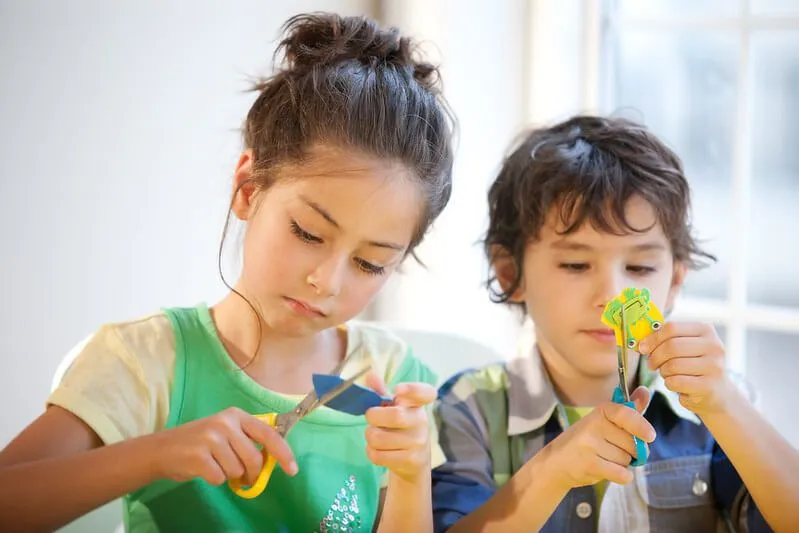FOR ALL AGES
Tell the kids that they are going to be allowed to drop eggs on the floor and you'll have already have caught their interest in this fun egg drop challenge.
Perfect for KS1 and KS kids (although we've seen plenty of older kids have fun with it too), the egg drop challenge is the ideal STEM activity and is popular with schools. Along with offering the chance to explore gravity, force and acceleration, it introduces the basic concepts of engineering, as the children must devise a container that will keep the egg safe when it is dropped from a specified height.
Practical science experiments are such fun that your kids won't even realise they are learning! Encouraging fun science and engineering projects at home will help nurture an interest at an early age, and as these skills make school leavers and graduates highly employable, you'll be doing your kids a favour!
Here at Kidadl, we love trying science experiments at home with our kids. However, we recognise that not all science ideas are appropriate and suitable for all children and families or in all circumstances. Therefore we recommend that these ideas are used as inspiration, that ideas are undertaken with appropriate adult supervision, and that each adult uses their own knowledge of their children to consider the suitability of each project.

Your mission is clear. You must design and build a contraption that will protect a raw egg that is dropped from one metre (3.3ft). If you egg smashes or cracks when you drop it, your mission has failed!
You need to offer various materials that could be used to create a container or to wrap up the eggs. Just use what you have to hand. You don't need everything listed here, however, if you can provide a number of different materials, they may be able to create several different contraptions, see how they work, and compare results.
Raw egg/s
Sticky tape
Balloons
Cotton wool
Bubble wrap
Cardboard
Toilet paper
Marshmallows
Tape measure or ruler
Flat washing up sponge
Toilet roll inner tubes
Craft sticks
Plastic containers
Tinfoil
Paper for drawing

Draw the protective contraption you plan to create for your egg drop challenge. You can design a number of ideas and if you have time, enough eggs and materials, create more than one.
Create your egg protector designs. Depending on the ability of your kids, you could challenge them to make it using the least materials possible for their egg drop contraption. Different designs include:
Egg wrap - wrap the egg in bubble wrap and cotton wool to protect it. Keep it in place with sticky tape. Use foil or more bubble wrap to hold it together.
Airdrop: Blow up a balloon, tape it onto the egg.
The last straw: Create a protective container using straws to build a frame around the egg, which should cushion it on impact. Join the straws together with sticky tape or stick the ends into marshmallows or putty. You could make the straws into a triangular tent-like structure, with the longer straws sticking out so they hit the ground before the egg to protect it. Or you could tape the straws close together and build a 'box'. You can fill any empty spaces with cotton wool, newspaper, or bubble wrap to add protection.

The cube: Make a cube-like structure from straws or sticks, with the egg suspended in its centre in a smaller cube shape.
Parachute game: Fashion a parachute out of an old plastic bag and some string or thread. Use on its own or in conjunction with another design.
On a roll: Lay a flat sponge down and tape an egg in the centre. Stand four toilet roll inners around it and tape all of them together. You can tape another sponge or bubble wrap on top.
Keep contained: Place the egg in a container with a lid (an old margarine tub or Tupperware box). Pack around it with a protective material such as cotton wool.
In the bag: Younger children who aren't able to create a structure can use a food/freezer bag that zips shut instead. Place the egg in the bag and create a nest around it by filling the bag with different materials, such as cotton wool, feathers, bubble wrap - you can even fill the bag with water (you might want to tape the bag up for this option to avoid a watery mess!) This is also a good idea if you or the children are not keen on making a mess of raw egg in your kitchen!
Depending on their ability and willingness to write, get your children to predict what will happen to the egg when it is dropped. You can add in varying factors - materials used for protection, the height from which it is dropped. If they can't/don't want to write, get them to tell you, or record their predictions on video. They could also create a scatter graph marking their predictions. Once they get the results they could mark those on as well. Older children can compare and contrast results.
Decide on the height you choose for your egg challenge drop. The challenge is to keep the egg whole at a 1m drop. If your egg survives you could keep increasing the height, to see which constructions work best.
Measure the height against a table leg or door frame so that they are accurate.
Chalk a target onto the floor so that the egg drop always happens in the same place.
Each egg must be dropped in the same way - no throwing it upwards, lowering it the height etc.
Keep a record of each egg drop, and the height when and if each egg breaks.
Consider why some constructions worked for the egg drop and some did not. Think about how you could use what you have learned to improve the constructions and carry out more egg challenges.

This egg drop challenge helps to demonstrate the forces acting on your egg. If you drop something, it falls to the ground because of gravity. Gravity pulls the object to Earth. You can also study air resistance - as some of the creations will drop to the ground faster than others. Those with a parachute should fall slower.
If you want to try other egg drop experiments, this one is impressive. Half fill a glass with water. On top, place a sandwich cake tin, right side up, then balance a toilet roll inner on that, so it is standing up. Finally, place the egg on top of the tube, so it is lying on its side. Hit the side of the baking tin so that it moves sideways off the glass. The egg should drop safely into the water. The reason it works is due to inertia. This says that your egg will stay at rest unless an outside force (your hand) acts upon it. So when you move the baking tin, gravity takes over and pulls the eggs downwards.
Read The Disclaimer
At Kidadl we pride ourselves on offering families original ideas to make the most of time spent together at home or out and about, wherever you are in the world. We strive to recommend the very best things that are suggested by our community and are things we would do ourselves - our aim is to be the trusted friend to parents.
We try our very best, but cannot guarantee perfection. We will always aim to give you accurate information at the date of publication - however, information does change, so it’s important you do your own research, double-check and make the decision that is right for your family.
Kidadl provides inspiration to entertain and educate your children. We recognise that not all activities and ideas are appropriate and suitable for all children and families or in all circumstances. Our recommended activities are based on age but these are a guide. We recommend that these ideas are used as inspiration, that ideas are undertaken with appropriate adult supervision, and that each adult uses their own discretion and knowledge of their children to consider the safety and suitability.
Kidadl cannot accept liability for the execution of these ideas, and parental supervision is advised at all times, as safety is paramount. Anyone using the information provided by Kidadl does so at their own risk and we can not accept liability if things go wrong.
Kidadl is independent and to make our service free to you the reader we are supported by advertising.
We hope you love our recommendations for products and services! What we suggest is selected independently by the Kidadl team. If you purchase using the buy now button we may earn a small commission. This does not influence our choices. Please note: prices are correct and items are available at the time the article was published.
Kidadl has a number of affiliate partners that we work with including Amazon. Please note that Kidadl is a participant in the Amazon Services LLC Associates Program, an affiliate advertising program designed to provide a means for sites to earn advertising fees by advertising and linking to amazon.
We also link to other websites, but are not responsible for their content.
Was this article helpful?



Browse Category



We’ll send you tons of inspiration to help you find a hidden gem in your local area or plan a big day out.



Check your inbox for your latest news from us. You have subscribed to:
Remember that you can always manage your preferences or unsubscribe through the link at the foot of each newsletter.